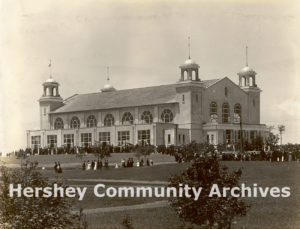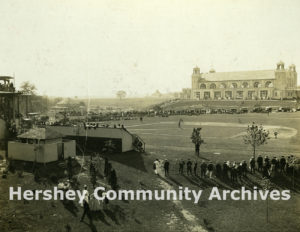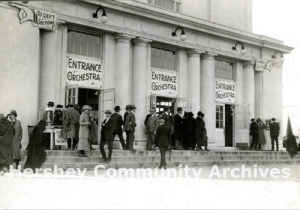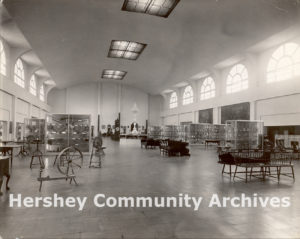Hershey Convention Hall
Throughout its history, Hershey has been a well-known destination for entertainment.
After the Hershey Chocolate Factory opened in 1905, the town soon emerged as a popular regional destination. Visitors came to explore the model town and enjoy Hershey Park and its growing number of amenities.
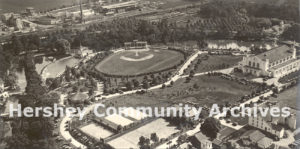
In 1914, Hershey’s weekly newspaper, the Hershey Press, announced that a convention hall was going to be erected in Hershey Park. The Convention Hall was built specifically to attract large events and big crowds to Hershey. Milton Hershey was very interested in hosting the Church of the Brethren’s Triennial Conference and promised that the Convention Hall would be completed in time for their June 1915 conference. This event brought more than 50,000 people to Hershey.
What would become the Hershey Convention Hall was originally described as a Chautauqua Hall, similar to other facilities across the United States, that fostered adult learning. Before the building was completed, it was officially named the “Hershey Convention Hall.” Milton Hershey envisioned the massive structure providing space for big conventions, important public exhibitions music festivals and all occasions requiring accommodations for 5000 to 7000 people. In developing plans for the assembly hall, Milton Hershey was inspired by a well known assembly hall in Ocean Grove, NJ and sent his builder, James K. Putt, to visit the structure to learn more about it and what might be incorporated in the Hershey building.
The new facility was easily accessible being located in Hershey Park near the miniature train line as well as the trolley line running to Highland Park (future site of the Hotel Hershey).
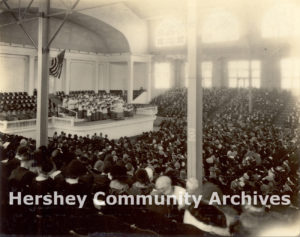
It was built specifically to attract large events and big crowds to Hershey. Its first function was the Triennial Convention of the Brethren Church. Milton Hershey was very interested in hosting this major event and promised the meeting planners that the Convention Hall would be completed in time for their conference. Construction began in March 1915 and the building was usable for a May 30th dedication service. While the building was able to house the attendees, finish work continued on the building after the meeting, most notably plastering the large assembly hall ceiling.
Building Specifications
The Hershey Press included a detailed description of the building. Built to be a permanent structure, the structure had concrete foundations and a limestone underground passage way 16 feet wide and 14 feet high that opened to a large (362 ft by 155 ft) open auditorium with a 71 foot high ceiling and a 18 inch deep gravel floor. This open area could be used for a variety of functions. Filled with benches it served as a convention or concert hall. For agricultural exhibitions the floor could also accommodate presentation rings. The open area was surrounded by a 17 row amphitheatre. With benches in the open area and the amphitheater there was seating for 6000 people. A loft offered seating for 600 more people. The building also included four large (15′ x 25′) meeting rooms.
The hall was electrically lit with new style nitrogen lights* that offered brighter light while using less electricity. The building’s four towers were designed for chimes (never installed) and each was lit with nitrogen lights.
The building was dedicated on Memorial Day weekend, May 30, 1915. Hershey Park opened for the season the following day, Memorial Day (Monday, May 31). The dedication program included a 40 piece band, the combined church choirs of Hershey, several vocal and instrumental soloists, as well as several speakers.
Dedication
The Convention Hall was not simply a large assembly hall. Milton Hershey’s vision for the building incorporated many of his goals and vision for his community. The Hershey Press carried this announcement about the building’s dedication:
Dedication
Hershey Convention Hall is dedicated to the service of the people. May they meet often within its walls and by their proceedings and discussions find wisdom. May they listen to words that will guide them in the paths of peace and righteousness. May they hear music that will uplift them. May they gather the products of their fields and factories and stimulate one another to higher achievements in agriculture, manufacture, commerce and the arts. May they learn more of the great principles of consolidation and co-operation. May they be imbued with the spirit of brotherhood, of courtesy and of helpfulness. May the services on Memorial Day exalting the patriotism of our heroes be a true dedication of this Hall to the welfare of a free people, the cause of liberty, the love of the Flag and the glory of God.
Appearing at the Convention Hall
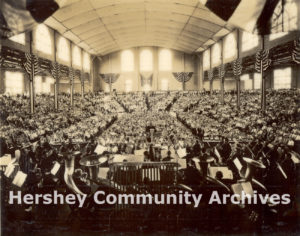
The 1915 addition of the Hershey Convention Hall transformed Hershey into a destination capable of hosting large conventions and national performers. Seating 6,000, the Convention Hall was a popular destination for both nationally celebrated performers and as a meeting venue for large organizations. True to his vision, the Convention Hall hosted a variety of events over its years of service.
The Convention Hall hosted nationally and internationally celebrated performers, including New York Metropolitan Opera singers, the Paul Whiteman Orchestra, the Sistine Chapel Choir during its first American tour, and nationally recognized marching bands.
The Ice Palace
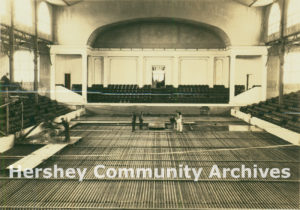
The 1930s brought new forms of entertainment to the community. In 1931, the Convention Hall was remodeled and an ice rink was added. This gave Hershey a venue to host professional ice hockey and figure skating. A Hershey Park facility could now be used all year long.
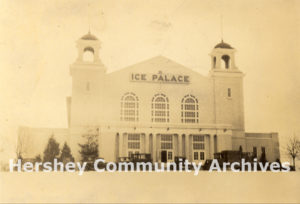
During the winter of 1931 the ice rink served as the home for the Swarthmore College ice hockey team. The community’s interest in skating was contagious. Ice hockey was so popular that Hershey sponsored its own semi-pro team, the Hershey B’Ars, the following year.
Figure skating became very popular and in 1934 the Hershey Figure Skating Club was established. Annual shows attracted thousands of attendees, and the shows often sold out weeks in advance.
Hershey’s enthusiasm for hockey and ice skating soon made the Ice Palace too small for all those wanting to attend hockey games. On several occasions hundreds of people were turned away due to lack of space. The Ice Palace was replaced by the Hershey Sports Arena in December 1936.
Hershey Sports Arena
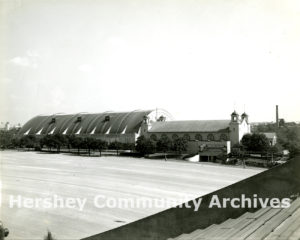
After the Hershey Sports Arena opened in 1936, the Convention Hall was re-purposed to serve as a new home for the Hershey Museum. The museum needed more space to present its growing collections. Locating the museum in the heart of Hershey’s entertainment venues enhanced access to the museum’s exhibits.
Hershey Museum continued to occupy the Convention Hall until 2009 when a new facility on Chocolate Avenue was built for a redeveloped museum, The Hershey Story.
Hershey Convention Hall Chronology
5/30/1915 | Hershey Convention Hall is dedicated as part of the Memorial Day celebration.
6/8/1915-6/13/1915 | Church of the Brethren hold their triennial convention at the Convention Hall. This is the facility’s inaugural event.
9/6/1915 | Harrisburg Evangelistic Chorus of Harrisburg performs on Labor Day.
6/10/1921-6/12/1921 | Church of the Brethren convention.
6/12/1921 | Apollo Male Chorus of Harrisburg performs at Convention Hall.
6/13/1921 | Dr. M.G. Brumbaugh, former governor of PA, preacher, educator, and lecturer, speaks on doctrine of Peace and Disarmament.
5/30/1922 | Geraldine Farra performs a concert at Convention Hall on Memorial Day. Farra was a noted opera singer and silent film star.
5/30/1923 | Julia Claussen, prima donna mezzo soprano, and Paul Althouse, noted tenor, both of the Metropolitan Opera House, perform a joint recital at the Convention Hall on Memorial Day.
6/16/1923-6/17/1923 | In honor of the community’s 20th anniversary, Creatore’s Band and Pennsylvania’s Bethlehem Bach Choir perform concerts daily.
8/25/1923-8/26/1923 | Creatore’s Band returns to Hershey to perform a second time this summer at the Convention Hall Four concerts are offered over the two days.
10/21/1923 | The 55-voice Sistine Chapel Choir performs as the Convention Hall during its first American tour.
6/13/1924-6/15/1924 | Church of the Brethren Convention meets in Hershey.
7/13/1924 | Mooseheart’s Boys’ Band gives two concerts at the Convention Hall.
8/17/1924 | Paul Whiteman and his orchestra performs in Convention Hall.
9/1/1924 | Paul Whiteman and his orchestra performs a second time this season in the Convention Hall.
6/4/1925 | Hershey Senior High School holds its commencement ceremony at the Convention Hall.
7/4/1925-7/5/1925 | John Philip Sousa and his band performs two concerts at the Convention Hall.
7/25/1925-7/26/1925 | Creatore and his band performs two concerts during each day at the Convention Hall.
5/30/1926 | Marion Talley, prima donna soprano of the Metropolitan Opera Company, gives a concert.
6/28/1926-6/30/1926 | Pennsylvania State Christian Endeavor Convention meet at Convention Hall.
7/4/1926-7/5/1926 | John Philip Sousa and his band performs two concerts each day at the Convention Hall.
5/30/1927 | Will Rogers, the great cowboy humorist, performs at Convention Hall.
1931 | Convention Hall is converted into the Ice Palace with 1900 seats.
2/17/1931 | First hockey game in the Convention Hall/Ice Palace. Penn Athletic Club v. Villanova.
2/16/1935 | Hershey Figure Skating Club holds its 2nd Ice Carnival in the Ice Palace.
* Nitrogen lights were a new innovation in lighting. More efficient than traditional incandescent lights, producing 5000 candlepower while consuming 2500 watts. They were described as being “100% more efficient than the modern Tungsten lamps and the latest design in incandescent lights.” [New York Times, 11/15/1913] (one candlepower = 12.57 lumens). The Convention Hall featured 16 200-watt nitrogen lights and 24 100-watt nitrogen lights and scores of more traditional tungsten electric lights.
